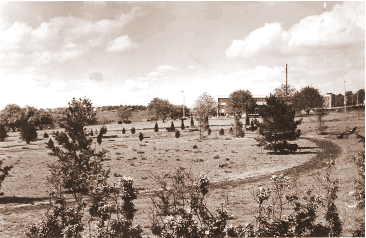

History
"A. Fatu" Botanic Garden of Iasi has a tumultuous history that has passed by over a century period to become as we are seeing and admiring today.
Among other cultural priorities of the ancient capital of Moldavia, a special place is granted to the setting up, in 1856, of the first botanic garden of Romania, by the physician and naturalist Anastasie Fatu, a great patriot, philanthropist and highly cultivated man. Situated on a terrain bought with his own funds in the immediate vicinity of the Rāpa Galbena point, this first garden has to be for many years, until the death of its great promoter, both an important cultural centre for the studious youth of Iasi, that had the possibility to study botany on living material, and an instruction and education instrument for all nature admirers.
This is what just Anastasie Fatu has wrote in 1870 in the preface of "The enumeration of the species cultivated in the Botanic Garden of Iasi" paper, regarding the setting up and the purposes of this garden: "Since 1856 I have founded the Botanic Garden of Iasi. This institution, that in the beginning have evolved very slow, being reduced to my own possibilities, later, it has prospered due to the subventions offered by the Townhouse of Iasi".
"Founding this garden, I have proposed to myself to improve the salubrity of the city, to stimulate the studious youth to learn botany and to assure to the natural sciences lovers the opportunity to contemplate the nature beauties in their rest moments".
By his financial efforts intermittently sustained by the public authorities, the garden lasted until A. Fatu's death (1886), after that, the terrain has been sold by his successors and all the botanic material gathered in his lifetime has been wasted.
Two streets from the proximity of the ex-garden: the Flowers street and the A. Fatu street have been named in respect and memory of the first Botanic Garden in Romania and its founder.
Stimulated by the interest expressed for the A. Fatu's garden, the "Physicians and Naturalists Society" from Iasi founds in 1873 a second Botanic Garden, round about the residence of this society, that, at the present moment is the Natural History Museum. The mission of the organization of this new garden is given to Dr. Dimitrie Brandza and the necessary funds have been provided by the society. A. Fatu has offered most of the species cultivated in this new garden as living plants or seeds. Some of the plants cultivated by D. Branza (two oaks, two poplars and one horse chestnut) can still be admired today in the small park from the Natural History Museum yard.

In 1870 the leadership of the University from Iasi take into consideration the problem of the organization its own botanic garden, on a terrain situated behind the old building of the University, where, at the present moment there are the buildings of the Medicine and Pharmacy University. After that, some plantations have been realized but just in 1876 have been allocated the funds that have permitted an ample development of the garden. It seems that both the allocated funds and the space around the University have not been enough to satisfy the requests of the university youth, the garden presenting a symbolic existence.
In 1900 at the repeated insistences (since 1895) of the prof. Al. Popovici, the University asks the terrain from the back of the actual Culture Palace to organize there a new botanic garden. The repeated attempting to obtain the necessary funds to realize this garden has remained uselessly. Although a very detailed organization project has been realized, it has not been finalized due to funds absence and, later, due to the consequences of the First World War. Only the "Botanica" street remember us today of that project.
To satisfy the requirements of the biological education, in 1921, Prof. Al. Popovici organizes a new botanic garden presenting approximately 1 ha area, on a terrain situated in the back of the new University building. A small greenhouses complex for tropical plants has been constructed there.
This garden served the botanic education over 40 years until 1963-1964 when it has been moved on the actual emplacement, in Copou Hill. Trees, shrubs from the old garden and a small "tower greenhouse" (where palm trees and banana trees were cultivated) are preserved today in the park between the old building of the University, student's canteen and student's campus.
In 1960, during the celebration of the University centenary, the status of the Botanic Garden has been analysed and the conclusions were that it was not corresponding to the education process exigencies and, in 1963, the new emplacement, in Copou hillock, has been chosen. A technical – economic study has been elaborated and in the years to come the organization of roads and alleys, plantations, construction and population of the greenhouses have begun.
The terrain area has increased by the gradual adding of new surfaces and consequently, today, the Botanic Garden presents approximately 80 ha area.
Since 2000, the Botanical Garden of Iasi is one of the founding members of the "Botanic Gardens of Romania Association".
Suggestions & comments: Webmaster Copyright ©2023 Botanic Garden of Iasi. All rights reserved.